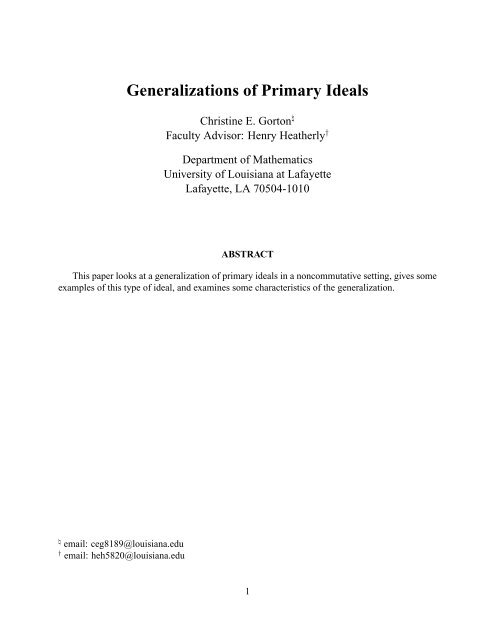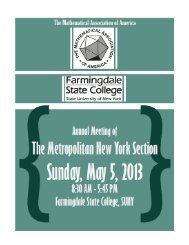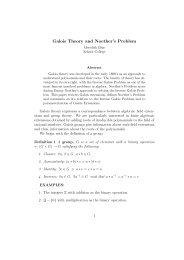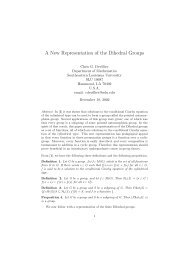Generalizations of Primary Ideals - MAA Sections
Generalizations of Primary Ideals - MAA Sections
Generalizations of Primary Ideals - MAA Sections
Create successful ePaper yourself
Turn your PDF publications into a flip-book with our unique Google optimized e-Paper software.
<strong>Generalizations</strong> <strong>of</strong> <strong>Primary</strong> <strong>Ideals</strong>Christine E. Gorton ♮Faculty Advisor: Henry Heatherly †Department <strong>of</strong> MathematicsUniversity <strong>of</strong> Louisiana at LafayetteLafayette, LA 70504-1010ABSTRACTThis paper looks at a generalization <strong>of</strong> primary ideals in a noncommutative setting, gives someexamples <strong>of</strong> this type <strong>of</strong> ideal, and examines some characteristics <strong>of</strong> the generalization.♮ email: ceg8189@louisiana.edu† email: heh5820@louisiana.edu1
In a commutative ring, an ideal I is called primary if for any two ring elements a and b such thatab ∈ I, then either a ∈ I or b k ∈ I for some positive integer k. <strong>Primary</strong> ideals are a generalization <strong>of</strong>the concept <strong>of</strong> prime ideals. Much is known about primary ideals in commutative rings, but whatsort <strong>of</strong> generalization might apply when we consider a ring which is not necessarily commutative?This is what we will consider in this paper. Some good sources for information on primary idealsin commutative rings, or on prime ideals are the references by Sharp [4] or Burton [1].Throughout this paper we will let R represent a ring which is not necessarily commutative andnot necessarily with unity (unless otherwise stated). Also we will use the notation N to representthe positive integers. We use the following definitions for a generalization <strong>of</strong> primary:Definition 1 : An ideal I in a ring R is said to be generalized right primary (generalized leftprimary) if for any two ideals A, B in R such that if AB ⊆ I, then either A ⊆ I or ∃k ∈ N sothat B k ⊆ I (B ⊆ I or ∃m ∈ N so that A m ⊆ I). A ring is said to be generalized right primary(generalized left primary) if the zero ideal is generalized right primary (generalized left primary).These definitions were given by Chatters and Hajarnavis [2] with slightly different terminology.Throughout the rest <strong>of</strong> the paper we use g.r.p. and g.l.p. to denote generalized right primary andgeneralized left primary respectively.Note that a prime ideal is both g.r.p. and g.l.p. Also, in a commutative ring, g.r.p and g.l.p. eachimply the ideal is primary. However, in general the two ideas are not equivalent. The followingexample demonstrates this:Example 1 Let S be a semigroup with the elements {a, b} and multiplication defined by the followingtable:a ba a bb a bNow let R be the semigroup ring Z 2 [S]. An easy calculation shows that this ring is g.l.p. but notg.r.p.One <strong>of</strong> the first things one might want to know about g.r.p. ideals and g.l.p. ideals is where canwe find examples <strong>of</strong> them. It is known that in commutative rings with unity, powers <strong>of</strong> maximalideals are primary. See [1, p.83] for one pro<strong>of</strong> <strong>of</strong> this. In fact we can show that in any ring withunity, powers <strong>of</strong> maximal ideals give us examples <strong>of</strong> g.r.p. and g.l.p. ideals.Theorem 1 Let R be a ring with unity, and M a maximal ideal <strong>of</strong> R. For n ∈ N, M n is a g.r.p. idealand a g.l.p. ideal.Pro<strong>of</strong>: For n = 1, M is a prime ideal and hence is g.r.p. and g.l.p. Take n ≥ 2. Let A, B beideals in R such that AB ⊆ M n and suppose A M n . Then R = R/M is a simple ring. Let A andB be the images <strong>of</strong> A and B in R. We have four cases to consider:(i) A ⊆ M, B ⊆ M;(ii)A + M = R, B ⊆ M;(iii) A + M = R, B + M = R;(iv) A ⊆ M, B + M = R.2
In cases (i) and (ii) B ⊆ M implies B n ⊆ M n . In case (iii) A + M = R implies AB + MB = RB.So B = RB = AB + MB ⊆ M n + M ⊆ M. Thus B n ⊆ M n .Now assume case (iv) holds. Then A = AR = AB + AM ⊆ M n + M 2 ⊆ M 2 . But then A ⊆ M 2implies A = AR = AB + AM ⊆ M n + M 3 ⊆ M 3 . Continuing this process eventually gives A ⊆M n , a contradiction.Thus M n is g.r.p. A similar pro<strong>of</strong> shows M n is g.l.p.This yields a large class <strong>of</strong> ideals which are g.r.p. and g.l.p. We next consider how ideals whichare g.r.p. (g.l.p.) can be used to find more such ideals.Definition 2 For any ideal I <strong>of</strong> R let √ I be the sum <strong>of</strong> all the ideals <strong>of</strong> R for which some power <strong>of</strong>the ideal is contained in I. If A is any ideal for which some power is in I, we call A a component <strong>of</strong>√IṪhus√I is the preimage in R <strong>of</strong> all the nilpotent ideals in R/I. This is then one possiblegeneralization to noncommutative rings <strong>of</strong> the classical radical <strong>of</strong> an ideal used in commutativering theory.Recall that any finite sum <strong>of</strong> nilpotent ideals is nilpotent. (For more on this see [3, p.19]). Thusany finite sum <strong>of</strong> components <strong>of</strong> √ I must be a component <strong>of</strong> √ I. And since any x ∈ √ I is insome finite sum <strong>of</strong> components <strong>of</strong> √ I, it follows that x is in a component <strong>of</strong> √ I.Lemma 1 If A and B are ideals <strong>of</strong> a ring R then √ A ∩ B = √ A ∩ √ B.Pro<strong>of</strong>: If x ∈ √ A and x ∈ √ B then x is in a component <strong>of</strong> √ A and in a component <strong>of</strong> √ B.Thus there exist ideals W and V <strong>of</strong> R and m ∈ N such that x ∈ W ∩ V and W m ⊆ A, V m ⊆ B.Consequently, (W ∩ V ) m ⊆ A ∩ B and hence x ∈ √ A ∩ B. So √ A ∩ √ B ⊆ √ A ∩ B. It isimmediate from the definition <strong>of</strong> √ that √ A ∩ B ⊆ √ A ∩ √ B.Lemma 2 Let A j , j = 1,. . . , n be ideals <strong>of</strong> R and let A = ∩ n j=1A j . Then √ A = ⋂ nj=1√Aj .Pro<strong>of</strong>: The pro<strong>of</strong> uses Lemma 1 and induction on n.Lemma 3 Let R be a ring in which every ideal is finitely generated, and let A, B be g.r.p. ideals inR. If √ A = √ B, then A ∩ B is a g.r.p. ideal <strong>of</strong> R.Pro<strong>of</strong>: Let U, V be ideals <strong>of</strong> R such that UV ⊆ A ∩ B, but U A ∩ B. This yields threepossible cases:(i) ∃ m, k ∈ N such that V k ⊆ A and V m ⊆ B; then V q ⊆ A ∩ B, where q = max{m, k}.(ii) U ⊆ A, ∃m ∈ N such that V m ⊆ B;(iii) ∃k ∈ N such that V k ⊆ A, U ⊆ B.Consider case (ii). V is finitely generated, say V = (x 1 , x 2 , . . . , x n ). Now for each i: 1 ≤ i ≤n, x i ∈ √ B = √ A. Thus x i is an element <strong>of</strong> a component W i <strong>of</strong> √ A.Then x i ∈ W = ∑ nj=1 W j, for each i. Thus V ⊆ W . But W is a component <strong>of</strong> √ A. So thereexists l ∈ N such that V l ⊆ W l ⊆ A. And then V q ⊆ A ∩ B where q = max{m, l}.A similar pro<strong>of</strong> holds for case (iii).Finally, the we get the following result concerning intersections <strong>of</strong> g.r.p. ideals.3
Theorem 2 Let R be a ring in which every ideal is finitely generated, and let A j , j = 1, . . . , n beg.r.p. ideals <strong>of</strong> R. If √ A 1 = · · · = √ A n then A = ⋂ nj=1 A j is a g.r.p. ideal <strong>of</strong> R.Pro<strong>of</strong>: The pro<strong>of</strong> follows by induction on n, using Lemma 3.4
References[1] D. M. Burton, A First Course in Rings and <strong>Ideals</strong>, Addison-Wesley, Reading, 1970.[2] A. W. Chatters and C. R. Hajarnavis, ”Non-Commutative Rings with <strong>Primary</strong> Decomposition”,Quarterly Journal <strong>of</strong> Math. Oxford(2), 22 (1971), 73-83.[3] N. J. Divinsky, Rings and Radicals, University <strong>of</strong> Toronto Press, 1965.[4] R. Y. Sharp, Steps in Commutative Algebra, London Mathematical Society Student Texts 19,Cambridge University Press, Cambridge, 1990.5
















